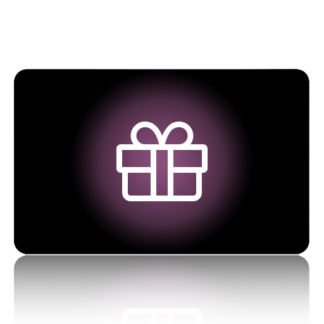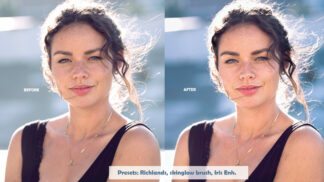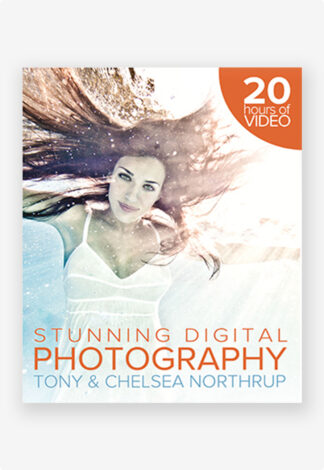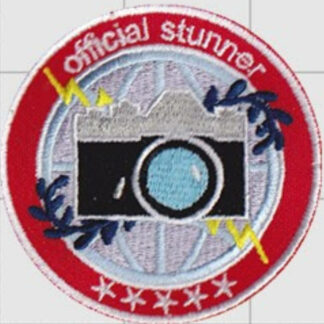Apple Boxes
 For a traditional portrait, the lens should be slightly above the model’s eye level. This is going to be a problem unless every model is about four inches shorter than you. We studio photographers use apple boxes to change either the subject height or the model height. If the model is more than about six inches shorter than me and I don’t want to kneel or crouch, I’ll have the model stand on an apple box. If the model is my height or taller, I’ll stand on the apple box. Apple boxes are also critical for equalizing height in family portraits. Have shorter subjects stand on boxes so the height differences are minimized. You’ll need apple boxes in at least three sizes so that you can adjust heights differently. Naturally, you can stack multiple apple boxes as needed. In a pinch, you can use large books, cinder blocks, or bricks.
For a traditional portrait, the lens should be slightly above the model’s eye level. This is going to be a problem unless every model is about four inches shorter than you. We studio photographers use apple boxes to change either the subject height or the model height. If the model is more than about six inches shorter than me and I don’t want to kneel or crouch, I’ll have the model stand on an apple box. If the model is my height or taller, I’ll stand on the apple box. Apple boxes are also critical for equalizing height in family portraits. Have shorter subjects stand on boxes so the height differences are minimized. You’ll need apple boxes in at least three sizes so that you can adjust heights differently. Naturally, you can stack multiple apple boxes as needed. In a pinch, you can use large books, cinder blocks, or bricks.
Posing Stools
 Stools used to be a standard element in a photography studio. Nowadays, however, most models simply stand (for an individual portrait) or kneel (for group photos where you need to equalize height). Stools are still useful for children, however, because having a child sit on a stool helps to keep him or her in a single place. Stools are also useful as an alternative to apple boxes for adjusting the height of your subject. Posing stools should rotate, have adjustable height, and have a foot rest and wheels. They shouldn’t have a back (which might appear in pictures).
Stools used to be a standard element in a photography studio. Nowadays, however, most models simply stand (for an individual portrait) or kneel (for group photos where you need to equalize height). Stools are still useful for children, however, because having a child sit on a stool helps to keep him or her in a single place. Stools are also useful as an alternative to apple boxes for adjusting the height of your subject. Posing stools should rotate, have adjustable height, and have a foot rest and wheels. They shouldn’t have a back (which might appear in pictures).
Reflectors
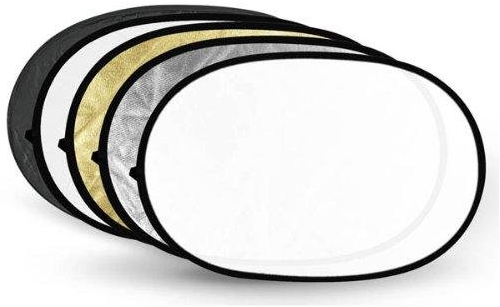 Reflectors bounce light. In a studio environment, photographers often use a reflector as an inexpensive fill light, to reduce shadow depth. Reflectors are commonly white, silver, or gold. White reflectors add a diffused fill light. Silver reflectors add more light, but the shadows won’t be as even. Gold reflectors add a touch of gold color to the light, which might make some skin tones more appealing. I typically use a white reflector first, and switch to a silver reflector only if the white reflector doesn’t add enough light. I’ll only use a gold reflector if my model has an extremely pale complexion.
Reflectors bounce light. In a studio environment, photographers often use a reflector as an inexpensive fill light, to reduce shadow depth. Reflectors are commonly white, silver, or gold. White reflectors add a diffused fill light. Silver reflectors add more light, but the shadows won’t be as even. Gold reflectors add a touch of gold color to the light, which might make some skin tones more appealing. I typically use a white reflector first, and switch to a silver reflector only if the white reflector doesn’t add enough light. I’ll only use a gold reflector if my model has an extremely pale complexion.
Fans and Wind Machines
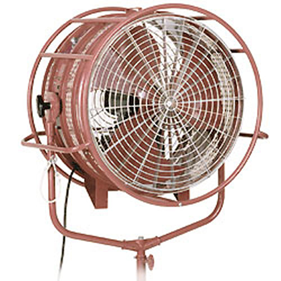
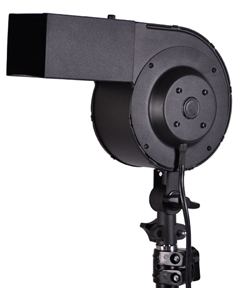 Fans blow the air around, creating movement in the model’s hair. A little bit of wind almost always improves photos of subjects with longer hair. It also helps to keep the model cool under the lights. Any standard pedestal fan is good enough for hair. You can use more powerful wind machines or even an electric leaf blower to add movement to dress fabric.
Fans blow the air around, creating movement in the model’s hair. A little bit of wind almost always improves photos of subjects with longer hair. It also helps to keep the model cool under the lights. Any standard pedestal fan is good enough for hair. You can use more powerful wind machines or even an electric leaf blower to add movement to dress fabric.
Tethering
Some photographers keep a computer in their studio and tether their camera directly to it. Tethering allows you to instantly review your photos on a larger screen. When working with Adobe Lightroom, you can even automatically apply some processing to the pictures to better assess the final image. Tethering is also useful in larger studios with a separate art director. The art director can examine the photos as they are shot, providing instant feedback to the photographer (without having to look over the photographer’s shoulder at the back of the camera). Most cameras can be tethered using Wi-Fi, possibly with a special SD card such as an Eye-Fi card. However, wireless tethering is too slow to be useful in most environments. For tethering to really be useful, you need a camera with wired Ethernet, such as a Canon 1DX, Nikon D4S, or most medium-format digital cameras. I almost always prefer not to tether when shooting in the studio. Being able to see pictures distracts models and can make them self-conscious. Instead, I prefer to select the best photos and show them to the model on the back of the camera.
Remote Shutter Release
 You can use a wireless remote shutter release to trigger your camera while you move around your studio. Obviously, this would only be useful if you had a still subject and had your camera on your tripod. However, that’s a common scenario in traditional portrait photography. Being able to move away from your camera can speed up portraits when working without an assistant. You can adjust a light or your model’s hair and instantly take a sample photo without walking back to your camera. You should only purchase a radio frequency (RF) remote shutter release. Infrared remote shutter releases are too unreliable to be useful.
You can use a wireless remote shutter release to trigger your camera while you move around your studio. Obviously, this would only be useful if you had a still subject and had your camera on your tripod. However, that’s a common scenario in traditional portrait photography. Being able to move away from your camera can speed up portraits when working without an assistant. You can adjust a light or your model’s hair and instantly take a sample photo without walking back to your camera. You should only purchase a radio frequency (RF) remote shutter release. Infrared remote shutter releases are too unreliable to be useful.

